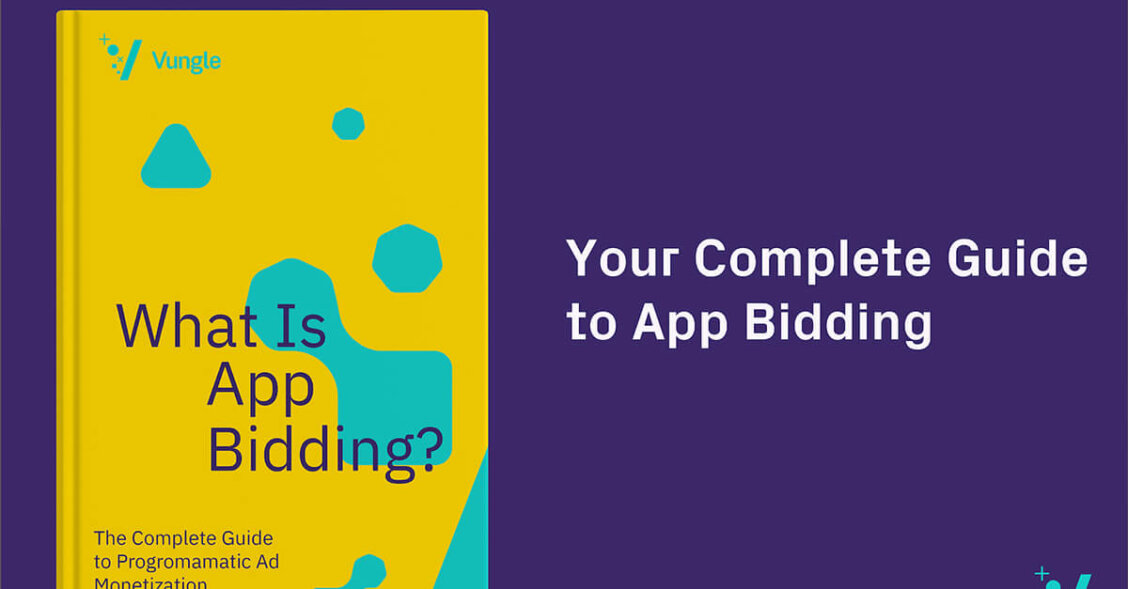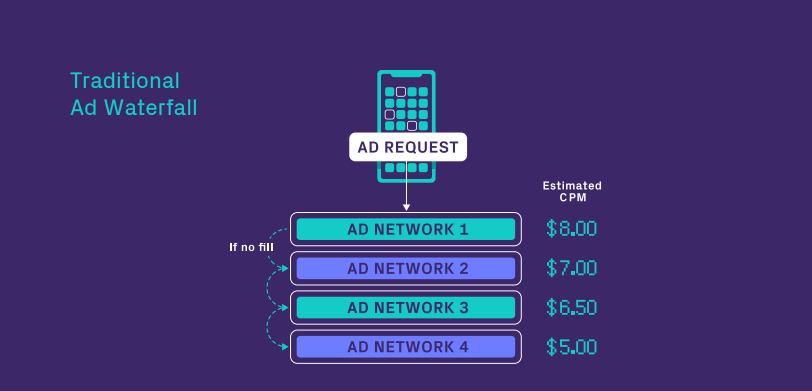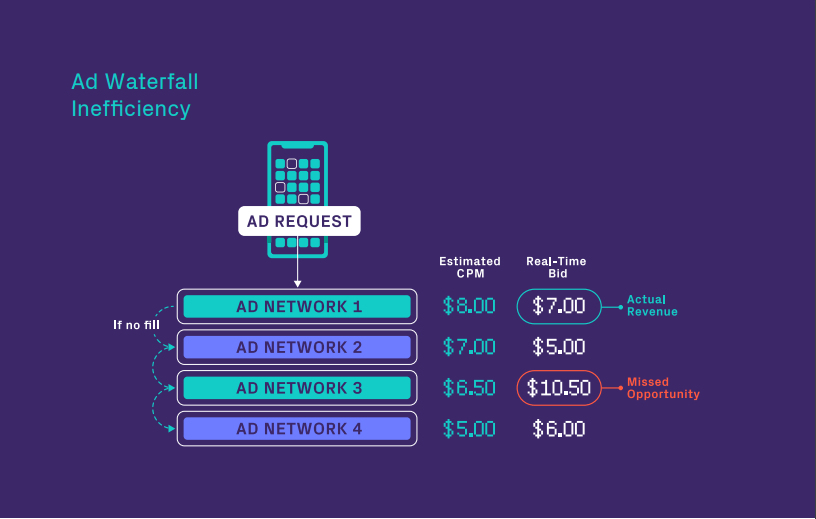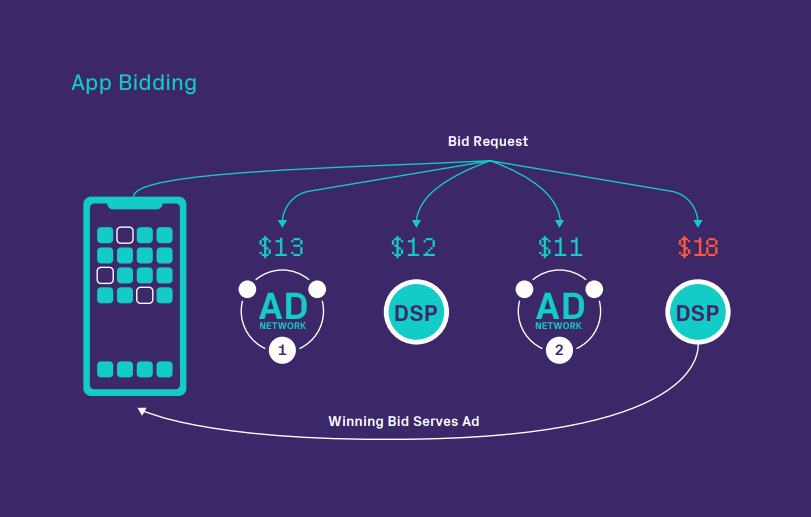
What Is App Bidding? The Complete Guide to Programmatic Ad Monetization
Introduction
Welcome to the wonderful world of app bidding!
Sometimes referred to as “in-app header bidding” due to its resemblance to a similar real-time bidding technology on the web, app bidding is poised to transform the mobile industry by improving efficiency and fostering fair competition. It evolved to promote transparent and equitable business practices in an industry that is sometimes compared to the Wild West. What began as a meritocratic solution to a unique monetization challenge has gained significant traction and is now spreading like wildfire.
Like many other ad tech innovations, the origins of app bidding lie in the desktop world, with what was originally known as header bidding. Header bidding has fuzzy origins, but it entered the common lexicon in 2015. Publishers had grown frustrated with Google’s last-look advantage and the resulting bias towards its own exchange, as well as the inefficiencies inherent to ad waterfalls, so they began to auction inventory in the page’s header in real time. What started as a hack soon transformed digital advertising forever.
App publishers had an equally strong desire to promote healthy competition, and programmatic selling seemed like the perfect answer. However, app bidding would require a more nuanced approach: App publishers often use SDK integrations which include non-standard features and introduce complexity to the bidding process. Moreover, solutions providers would need to account for a stratified ecosystem in which DSPs and SDK networks often compete for inventory.
In this article, we’ll explain what app bidding is, how it works, and what publishers stand to gain from implementation. Let’s dive in!
Table of Contents
What is app bidding?
What is in-app header bidding?
Programmatic auction vs. traditional mobile ad mediation
App bidding vs. programmatic mediation
What is a unified auction?
How is app bidding integrated?
What are the benefits of app bidding?
How much more can publishers earn from app bidding?
What are some app bidding best practices?
Get started with app bidding

What is app bidding?
App bidding is a programmatic advertising sales technique in which mobile app publishers offer inventory to multiple demand sources in real time via a unified auction. The approach allows media buyers with different models (e.g. programmatic ad networks, ad networks with mock bidders, and DSPs) to compete on an even playing field, increasing publisher revenue as a result.
All demand sources involved in the auction receive and process bid requests, typically using the OpenRTB protocol, that contains information they can use to programmatically determine what they’re willing to bid for the impression. Timeout periods are set by the publisher to ensure a smooth user experience, with only the bids coming in before the period has elapsed being considered. Once bids are returned and the winner is selected, the resulting ad is then served to the user. This entire transaction takes place in seconds.
What is in-app header bidding?
The term “in-app header bidding” is sometimes used to refer to what has come to be more widely known as app bidding. The term originally came into use as a way of likening app bidding to its desktop advertising predecessor, in which a similar auction would take place in a web page’s header. However, because there is no “header” in a mobile app, the term “in-app header bidding” is a bit of a misnomer. Different players in the industry also use terms like “in-app bidding” to describe the same functionality.

Programmatic auction vs. traditional mobile ad mediation
App publishers advocated for programmatic selling — so why do many continue to rely on traditional mediation? To get to the heart of this issue, we must understand how conventional mobile ad mediation works.
Traditional mobile ad mediation allows publishers to prioritize different demand sources based on their potential to drive revenue. This model is often referred to as a “waterfall” because the ad server calls networks in a predetermined, linear order. The order is based either on performance or publisher preference, but it relies on historical data rather than real-time data. This would typically include looking back at a period of time for each demand source, calculating the average revenue, and comparing the values to determine priority. The ad server calls the first ad network, then the second, and so on.

Waterfall monetization comes with its own unique set of tactics and best practices. Sometimes individual networks are given the chance to exhaust their demand before the waterfall moves onto the next, while other times publishers top-skim only the best performing (and typically first served) ads from each network. Some platforms use a weighted waterfall model in which ad networks are ordered based on their performance relative to one another.
Mediation platforms offer waterfall mediation via a single SDK. However, some publishers choose to build a custom mediation stack with a manual order. Meanwhile, a hybrid mediation model allows publishers to reap the benefits of a standard model and make manual adjustments as needed. From a revenue perspective, mediation is considerably more profitable than calling demand from a single ad network. In both cases, however, publishers may lose revenue because high-value demand partners are relegated to the bottom of the waterfall.
Because traditional ad waterfalls rely exclusively on historical data, they can easily miss out on new demand opportunities from sources that haven’t had sufficient opportunity to prove themselves. Advertisers are constantly updating their media buying strategies, and so new advertising revenue opportunities can arise at any given time. When relying exclusively on historical data, these opportunities can remain hidden to publishers, who then miss out on demand opportunities.

App bidding fixes this problem: Real-time auctions incorporate more demand sources, each of which is free to bid higher for more valuable impressions at the same time as all other demand sources competing for the impression. Higher bids and more competition means more publisher revenue. Real-time bidding also ensures that demand partners are consistently prioritized based on bid value, so publishers don’t lose out on opportunities deeper in the waterfall. Demand partners also benefit from RTB — they’re given access to inventory that wouldn’t otherwise have been available to them, and because all parties have full visibility into the auction process, they’re given visibility into the winning bid and can adjust accordingly.

App bidding vs. programmatic mediation
The term app bidding is often used interchangeably with “programmatic mediation.” However, programmatic mediation is a broader category that encompasses both app bidding and RTB (real-time bidding) technology. Publishers should be aware of this critical distinction: RTB protocols merely automate auctions through tag-based integrations. App bidding uses a transparent infrastructure that incorporates all demand sources. That means that programmatic and non-programmatic ad networks, DSPs, and other demand sources can compete on an equal footing. App bidding also facilitates a truly unified auction, making all bids visible to the publisher.
What is a unified auction?
Let’s unpack the phrase “unified auction” to drive this point home. The mobile ad ecosystem is fragmented — especially on the demand side. App publishers can source demand from direct deals, SDK networks, programmatic DSPs, and more. A unified auction aims to level the playing field, allowing demand sources with different models to compete for impressions in a fair, transparent environment. That means that even demand sources that lack RTB capabilities will be allowed to compete. Unified auctions are also more efficient because they send one call to all demand partners, eliminating passback costs and other transactional inefficiencies that publishers may incur.
Many solutions claim to support a unified auction but exclude certain demand sources, such as networks that lack RTB capabilities or traffic from direct deals. A truly unified auction will be demand-agnostic and free from bias while eliminating the need for a waterfall.
How is app bidding integrated?
Not all demand sources play by the same rules. Integration options, auction rules, ad formats, and ad rendering may vary between platforms. SDKs also offer custom capabilities, making APIs a vital feature of the app bidding ecosystem. For that reason, app bidding is not nearly as simple as its web-based predecessor.
Mobile ad mediation platforms can already support multiple SDKs within a single platform, so they became the first to offer app bidding solutions. Ad exchanges also offer app bidding via SDK, connecting publishers to DSPs and ad networks. This technology is relatively new and continually evolving. From a publisher’s perspective, the best app bidding solution will foster fair competition between ad networks and programmatic demand. The publisher benefits even more if the auctions occur within its primary ad server.
What are the benefits of app bidding?
Though many publishers continue to rely on other selling techniques, app bidding has created a buzz in the industry — and for good reason. That said, app bidding offers many benefits over traditional mobile ad mediation. The right solution will help you:
- Flatten the waterfall: The waterfall model uses historical data to determine the order of network calls. Once a network secures the top spot, they have little incentive to bid competitively, and eCPMs suffer as a result. App bidding uses real-time data, benefitting publishers, and media buyers alike. Media buyers also have the added benefit of accessing more premium inventory.
- Increase competition: Mobile ad networks are key revenue drivers for app publishers because they offer premium formats designed for mobile deployment. But managing multiple relationships may not be scalable. App bidding gives publishers the best of both worlds by allowing SDK networks to compete alongside major ad exchanges and DSPs at the same time, thereby increasing revenue. More fair competition is better for everyone.
- Improve transparency: The programmatic world has been referred to as a “black box” because of its lack of transparency. App bidding solves this by holding programmatic players to the same standards as networks. All bids are visible and all demand sources can see which bids are winning, while publishers can get a clear picture of what ads land in front of their users.
- Reduce manual work: Many publishers manually optimize their waterfalls on a recurring basis by running reports, analyzing the results, and adjusting demand sources in the waterfall. Managing this process is inefficient and time-consuming compared to app bidding.
Despite these benefits, some publishers are less bullish on app bidding than others. Often, objections are rooted in the associated fees or engineering work needed to initiate the system, or simply a lack of understanding of how it works. The technology is relatively new, and some solutions merely introduce complexity without delivering value.
How much more can publishers earn from app bidding?
Claims vary across the industry, but according to Facebook’s data, publishers typically see ARPDAU increase by 10-30% after implementing app bidding. Publishers also see a significant lift in yield compared to waterfall mediation. Adam Carey, formerly of SEGA, remarked that his team saw a 20% increase in yield thanks to greater efficiency and competition.
What are some app bidding best practices?
When it comes to app bidding, most of the legwork is in choosing the right platform. Over the past few years, the number of bidding platforms has exploded, so it’s essential to make a wise choice.
- Look for diverse demand sources: Your app bidding solution should include a range of mediated networks and a big DSP marketplace to promote healthy competition and drive revenue. Ideally, they will also support direct deals and cross-promotion and allow networks using historical data to bid.
- Follow the money: Choose a platform that offers fair, unbiased competition among demand sources and effective fees. If they can be beaten, choose another solution.
- A/B test bidding solutions: When in doubt, run a test. You may work with a mediation partner that offers an app bidding solution. Still, it could also be worth testing a platform that plugs into your existing monetization stack.
- Embrace parallel bidding: Ad tech evolves quickly, so some publishers choose to bet on multiple solutions at once. You can also take a hybrid approach, plugging in a programmatic platform lower in your waterfall.
- If it’s not broken, let it be: Some publishers may have invested in homegrown mediation solutions early on, or formed consistent, reliable partnerships. For them, now may not be the moment to embrace app bidding.
Get started with app bidding
Like programmatic media buying, app bidding is complicated. It can be nerve-racking to adopt a bidding solution — particularly if your current monetization stack is profitable. One way to ensure that your app bidding platform is up to snuff is to explore their demand sources. If you’re already a Vungle partner, you know that we partner with premium advertisers and produce creative that users love. Our dedicated team of app monetization experts is available to help you assess your options. Get in touch with us today to find out more!
